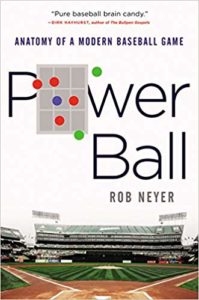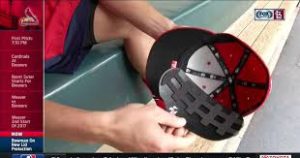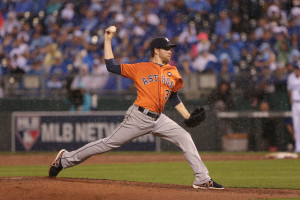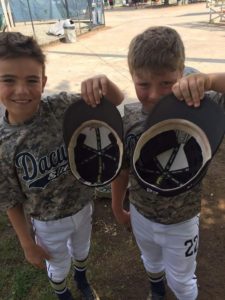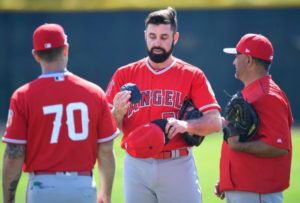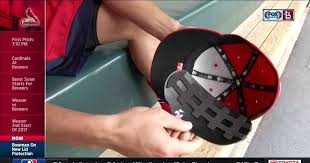A Brief History of Head Protection in Baseball and What the Might Future Hold
Nearly 100 years ago, the science of head injuries was nearly nonexistent. CTE had yet to be discovered and “traumatic brain injury” was not a mainstream phrase. Hitters didn’t wear any helmets or head protection at the plate. And pitchers… well, that would be silly wouldn’t it?
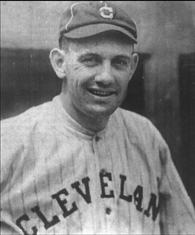
Ray Chapman, the first and only player to be killed from an injury in a Major League Baseball game.
In 1920 at the Polo Grounds, Ray Chapman would become the only Major League Baseball player in history to be fatally struck during a game. The opposing pitcher was a submariner who had a reputation of throwing high and tight against batters that would crowd the plate.
According to reports, Chapman managed to pick himself up off the ground and started walking towards the outfield wall where the clubhouses were located. He managed to make it a few feet past the mound before needing assistance. Shortly after, Chapman fell into a coma and passed away hours later.
It would take 36 years for Major League Baseball to mandate some type of head protection for all players at the plate. 36 years. The exact date that the batting helmet made it’s MLB debut remains unclear, though it was well before the MLB mandate.
In the early days, batting helmets was better known as the “beanball hat”. Even more than we see today, it was widely accepted and expected that pitchers were to throw at batters. Not always maliciously, but as an actual strategy to throw off timing and confidence. Baseball great Ralph Kiner went on to say that throwing at batters existed in that era of baseball “without restraint” and players started to gravitate towards using a protective device.
A few years prior to the implementation of batting helmets, player and legendary coach Don Zimmer nearly suffered the same fate as Ray Chapman.
Zimmer was struck by a pitch during a minor league game in 1953. He laid unconscious for nearly two weeks and required numerous procedures to remove blood clots and relieve the pressure being put on his brain. 1953 modern medicine had made huge strides since the days of Ray Chapman.
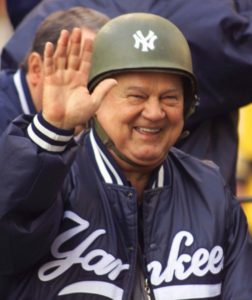
Don Zimmer survived a life threatening hit by pitch prior to mandatory MLB helmet use.
The 1941 Brooklyn Dodgers are credited with being the first to use a protective device in the form of plates that were permanently sown into caps. In 1953, Kiner, along with Phil Rizzuto, have been credited with being among the first players to wear the hard hat version of the baseball cap, a jockey style helmet produced by American Baseball Cap, Inc. Kiner admitted in his autobiography that widespread use of the helmet was slow to evolve because players were afraid that the opposing team would question their manhood; making anyone who wore it, a “sissy”.
Sound familiar? A nearly identical narrative is being played out with today’s pitchers but we’ll get to that in a minute.
The batting helmet continued it’s evolution into what we see today.
The official helmet of MLB is produced by Rawlings and made from aerospace grade carbon fiber. This material is 130 times stronger than standard ABS plastic. The S100 Pro Comp retails for $499.95. No helmet or protective device is concussion proof, but thanks to the helmet, we now hear about far fewer injuries at the plate.
So what about pitchers? Dating back to 2008, at least one MLB pitcher has been hit on the head or face by a line drive every year through the 2016 season. There have been at least two MLB pitchers hit every year since the 2013 season. The total number of active MLB pitchers at any given time is around 720, meaning, line drives to the head affect approximately 1 out of every 360 MLB pitchers. Not so bad, right?
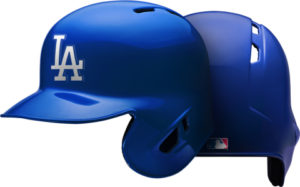
The S100 Pro Comp by Rawlings
Given this sample size we can build a pretty solid estimate for how this affects youth baseball players. According to the Washington Post, approximately 13.2 million kids ages 6-12 played youth baseball in the United States. Subtracting t-ball and coach pitch players, let’s say there are 5 million youth players who actually pitch. Given our MLB injury ratio, 14,000 youth players up to age 12 will suffer a head or face injury from a line drive, not including any players above the age of 12. And that is not so good. This is a problem that needs to be addressed now, not 36 years from now. Baseball should take a lesson from the pages of history. Let’s get in front of this thing.
Not quite two years ago now, SST was working on setting up the dealer network for our product and had established contacts with a major sporting goods retailer. They loved the product but had one concern: “what was going to drive sales of this product?” We quickly replied saying that we would in fact be driving the attention and sales of our product. The gentleman we were speaking with said, “No, something major would have to happen on national television, (a fatality) before this product is marketable.”
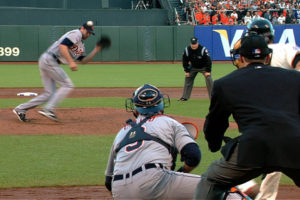
Doug Fister managed to escape serious injury after taking a line drive to the head during the 2012 World Series.
Head injury science is just now discovering the long term effects of brain trauma. The immediate effects have a wide range of severity. For example, former Detroit Tigers pitcher Doug Fister took a line drive to the side of the head during the 2012 World Series and stayed in the game, symptom free. No brain bleed, not even a concussion.
Not everyone is so fortunate.
Just months earlier, Oakland A’s pitcher Brandon McCarthy was hit by a line drive that required emergency surgery to save his life. The impact resulted in a skull fracture, brain contusion, and an epidural hemorrhage. Cases such as McCarthy’s are immediately serious due to the rupture of the middle meningeal artery that arises from the carotid artery. The middle meningeal artery branches off into all sides of the brain; when ruptured, the bleeding puts pressure on the brain which would eventually lead to coma and death.
Youth baseball represents the highest frequency of such injuries. At a developing age, it is easy to see how much more serious catastrophic head injuries can be. Just one of many cases involved a boy from Texas named Connor.
Here is Connor’s story of the incident and the days following as described by his mom, Kindra.
Saturday, April 9th Connor was pitching in a baseball game at a tournament in Beaumont, TX. The boy up to bat hit a line drive straight to Connors head hitting him at the top of the right ear and in the right temple area. My husband, J.R. and I were in the stands and saw everything. We honestly thought it had killed him. 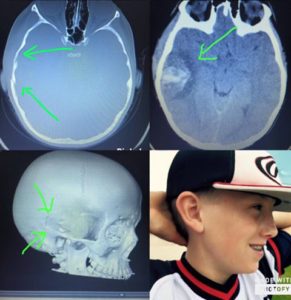 We ran as fast as we could to our child who was laying on the mound. I was so relieved to see his eyes open when I got to him, that he was conscious and he was talking. He kept saying his head felt weird. Somehow he was already being attended to by 2 nurses (Misty and Kelli, and Jason, an EMT) and a man named Blaine, an EMT who just came out of nowhere with a first aid bag. These people were literally like angels who were there attending to our son and keeping him calm. As they iced and wrapped his swollen head, my husband and I laid hands on our boy and prayed while trying to keep him awake and calm as we waited nearly 30 min for the ambulance to arrive. (WAY TO LONG TO WAIT!) We were surrounded by so many people praying at that moment, even all the cute little 12 year old boys, most of them praying through tears. I will never forget all those scared boys faces. I’m so sorry they had to witness that. Fast forward, we finally get to St Elizabeth’s Trauma Unit in Beaumont. Connor had started to throw up a ton on the way there and the vomiting didn’t stop for the next two days. They did a cat scan at St Elizabeth’s and within a few minutes were telling us his skull was cracked, he had bleeding on the brain and had a midline brain shift and that LifeFlight was on the way to transport him to Texas Children’s in downtown Houston. Once the flight nurses arrived my husband had to drive his truck to Houston and I got on the helicopter with Connor. He threw up most of the flight, I can only imagine the pressure on his head. His brain was swelling rapidly and they warned me during the flight that they would more than likely have to intubate him mid flight. That, that right there almost made me lose it. I prayed harder than I ever have! Praise God he did not have a seizure, he did not have to be intubated!!! Once we arrived in Houston, another ambulance picked us up and took us to Texas Children’s. We came in and there were a ton of doctors and nurses waiting in a room for us.
We ran as fast as we could to our child who was laying on the mound. I was so relieved to see his eyes open when I got to him, that he was conscious and he was talking. He kept saying his head felt weird. Somehow he was already being attended to by 2 nurses (Misty and Kelli, and Jason, an EMT) and a man named Blaine, an EMT who just came out of nowhere with a first aid bag. These people were literally like angels who were there attending to our son and keeping him calm. As they iced and wrapped his swollen head, my husband and I laid hands on our boy and prayed while trying to keep him awake and calm as we waited nearly 30 min for the ambulance to arrive. (WAY TO LONG TO WAIT!) We were surrounded by so many people praying at that moment, even all the cute little 12 year old boys, most of them praying through tears. I will never forget all those scared boys faces. I’m so sorry they had to witness that. Fast forward, we finally get to St Elizabeth’s Trauma Unit in Beaumont. Connor had started to throw up a ton on the way there and the vomiting didn’t stop for the next two days. They did a cat scan at St Elizabeth’s and within a few minutes were telling us his skull was cracked, he had bleeding on the brain and had a midline brain shift and that LifeFlight was on the way to transport him to Texas Children’s in downtown Houston. Once the flight nurses arrived my husband had to drive his truck to Houston and I got on the helicopter with Connor. He threw up most of the flight, I can only imagine the pressure on his head. His brain was swelling rapidly and they warned me during the flight that they would more than likely have to intubate him mid flight. That, that right there almost made me lose it. I prayed harder than I ever have! Praise God he did not have a seizure, he did not have to be intubated!!! Once we arrived in Houston, another ambulance picked us up and took us to Texas Children’s. We came in and there were a ton of doctors and nurses waiting in a room for us.
 We ran as fast as we could to our child who was laying on the mound. I was so relieved to see his eyes open when I got to him, that he was conscious and he was talking. He kept saying his head felt weird. Somehow he was already being attended to by 2 nurses (Misty and Kelli, and Jason, an EMT) and a man named Blaine, an EMT who just came out of nowhere with a first aid bag. These people were literally like angels who were there attending to our son and keeping him calm. As they iced and wrapped his swollen head, my husband and I laid hands on our boy and prayed while trying to keep him awake and calm as we waited nearly 30 min for the ambulance to arrive. (WAY TO LONG TO WAIT!) We were surrounded by so many people praying at that moment, even all the cute little 12 year old boys, most of them praying through tears. I will never forget all those scared boys faces. I’m so sorry they had to witness that. Fast forward, we finally get to St Elizabeth’s Trauma Unit in Beaumont. Connor had started to throw up a ton on the way there and the vomiting didn’t stop for the next two days. They did a cat scan at St Elizabeth’s and within a few minutes were telling us his skull was cracked, he had bleeding on the brain and had a midline brain shift and that LifeFlight was on the way to transport him to Texas Children’s in downtown Houston. Once the flight nurses arrived my husband had to drive his truck to Houston and I got on the helicopter with Connor. He threw up most of the flight, I can only imagine the pressure on his head. His brain was swelling rapidly and they warned me during the flight that they would more than likely have to intubate him mid flight. That, that right there almost made me lose it. I prayed harder than I ever have! Praise God he did not have a seizure, he did not have to be intubated!!! Once we arrived in Houston, another ambulance picked us up and took us to Texas Children’s. We came in and there were a ton of doctors and nurses waiting in a room for us.
We ran as fast as we could to our child who was laying on the mound. I was so relieved to see his eyes open when I got to him, that he was conscious and he was talking. He kept saying his head felt weird. Somehow he was already being attended to by 2 nurses (Misty and Kelli, and Jason, an EMT) and a man named Blaine, an EMT who just came out of nowhere with a first aid bag. These people were literally like angels who were there attending to our son and keeping him calm. As they iced and wrapped his swollen head, my husband and I laid hands on our boy and prayed while trying to keep him awake and calm as we waited nearly 30 min for the ambulance to arrive. (WAY TO LONG TO WAIT!) We were surrounded by so many people praying at that moment, even all the cute little 12 year old boys, most of them praying through tears. I will never forget all those scared boys faces. I’m so sorry they had to witness that. Fast forward, we finally get to St Elizabeth’s Trauma Unit in Beaumont. Connor had started to throw up a ton on the way there and the vomiting didn’t stop for the next two days. They did a cat scan at St Elizabeth’s and within a few minutes were telling us his skull was cracked, he had bleeding on the brain and had a midline brain shift and that LifeFlight was on the way to transport him to Texas Children’s in downtown Houston. Once the flight nurses arrived my husband had to drive his truck to Houston and I got on the helicopter with Connor. He threw up most of the flight, I can only imagine the pressure on his head. His brain was swelling rapidly and they warned me during the flight that they would more than likely have to intubate him mid flight. That, that right there almost made me lose it. I prayed harder than I ever have! Praise God he did not have a seizure, he did not have to be intubated!!! Once we arrived in Houston, another ambulance picked us up and took us to Texas Children’s. We came in and there were a ton of doctors and nurses waiting in a room for us.Once in the room I start hearing teams of doctors and nurses calling out commands and assessing Connor in such controlled chaos. It was like watching a perfectly choreographed dance. Connor was still getting sick and I’m sure he was terrified with all those people looking down on him and saying things he didn’t understand. They sent us to PICU (pediatric ICU). For two days he was in ICU. His heartbeat was dropping as his brain was swelling. His breathing was shallow, his sodium levels were dangerously low and the list goes on. His bleed was substantial and had gone into the brain tissue. It was about the size of a golf ball. All through this, Connor remained alert, coherent, smiling through pain, moving and talking! I was and am still amazed at his strength! Every time the neurosurgeons came in to discuss surgery, they were amazed at his progress. Looking at his scans showed he needed surgery, but Connor was telling a different story! He’s a fighter! God is so good! After two days in ICU they moved him to the neurology floor for 6 days. He still remained in pain that they tried to control with Tylenol and Ibuprofen. Poor thing was hurting so bad. Eventually the pain subsided and he got better and better. So, we finally were discharged and he got to go home. He’s now doing half days at school and recovering great! You would never even know he has a traumatic brain injury. He has a long road of just healing. No physical activity for 3 months. Connor had a crushed skull where the ball hit, fractured in 2 places, an epidural hematoma (brain bleed) with a midline brain shift.
Connor has since made a remarkable recovery and is back to being a kid again.
Guys, if you are still reading this, thank you. I could write for days but I promise that I’m wrapping this up. I started SST not to take advantage of parents or prey on fears. I started this company based on personal experience. I was 13 or 14 when I was struck by a line drive on the mound. However, my ordeal was nowhere near as severe as what many others have gone through.
From time to time I hear people say, JUST USE YOUR GLOVE! And, yes, we HIGHLY recommend that as well as finishing a pitch in proper fielding position! The reality is that when these injuries occur, the ball is simply hit too hard with too much velocity for the human body to react.
Our goal is not to change the game of baseball, instead we look to reduce the risks and consequences associated with severe head injuries on the mound and in the field. We are proud to have at least three MLB pitchers actively wearing our device. A fourth, Matt Shoemaker of the Angels, will be testing our device during 2017 Spring Training. Shoemaker is the latest MLB pitcher to have survived a line drive to the head that also required emergency surgery for a brain bleed.
So what does the future of head protection in baseball hold? Only time will tell. Hopefully, the decision will be made before the next Ray Chapman.
We welcome your questions and look forward to working with you as we seek to make the game a little safer. Questions, comments, feedback? Email us at info@sstcomposites.com.
– Matt, Founder, SST

 Previous Post
Previous Post Next Post
Next Post